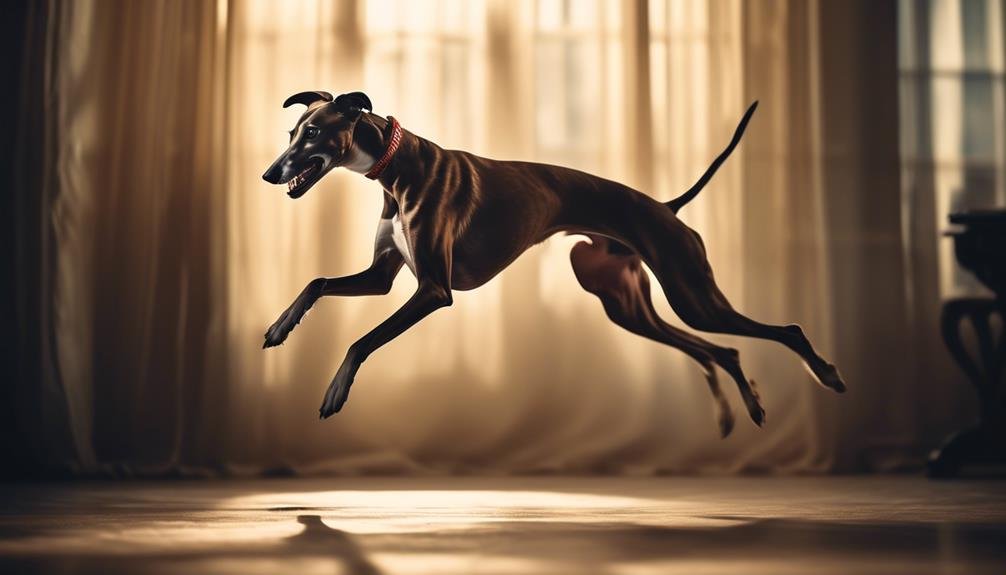They say, ‘You can’t judge a book by its cover,’ the same can be said for the Greyhound dog breed. At first glance, you may be captivated by their sleek and elegant appearance, but there is so much more to discover about these magnificent creatures.
From their impressive speed to their gentle and loving nature, Greyhounds have a unique set of characteristics that make them stand out from the crowd. But it doesn’t stop there.
In this article, we will explore their physical attributes and temperament and dive into their training needs, health considerations, and even tips on finding the perfect home for your Greyhound.
So, are you ready to uncover the secrets of this remarkable breed? Let’s begin.
Key Takeaways
- Greyhounds are known for their speed and elegance, often reflected in their names.
- Italian Greyhounds are a smaller breed with a more delicate appearance.
- Finding a reputable dog breeder is essential for ensuring the health and well-being of a Greyhound.
- When looking for a dog-friendly condo, consider policies, amenities, and locations that cater to the needs of a Greyhound.
History and Origin
The history and origin of Greyhounds can be traced back thousands of years, making them one of the oldest dog breeds. These elegant and swift canines have a rich history that dates back to ancient civilizations such as Egypt and Greece.
Greyhounds were highly prized for their exceptional speed and agility, which made them ideal for hunting small game like rabbits and foxes. Throughout history, Greyhounds have been favored by nobility and royalty, often depicted in ancient artwork and literature as symbols of grace and nobility.
Their origins can be found in the Middle East, and they were later brought to Europe, where they gained popularity as racing dogs. Today, Greyhounds are beloved companions known for their gentle nature and incredible athleticism.
Physical Characteristics
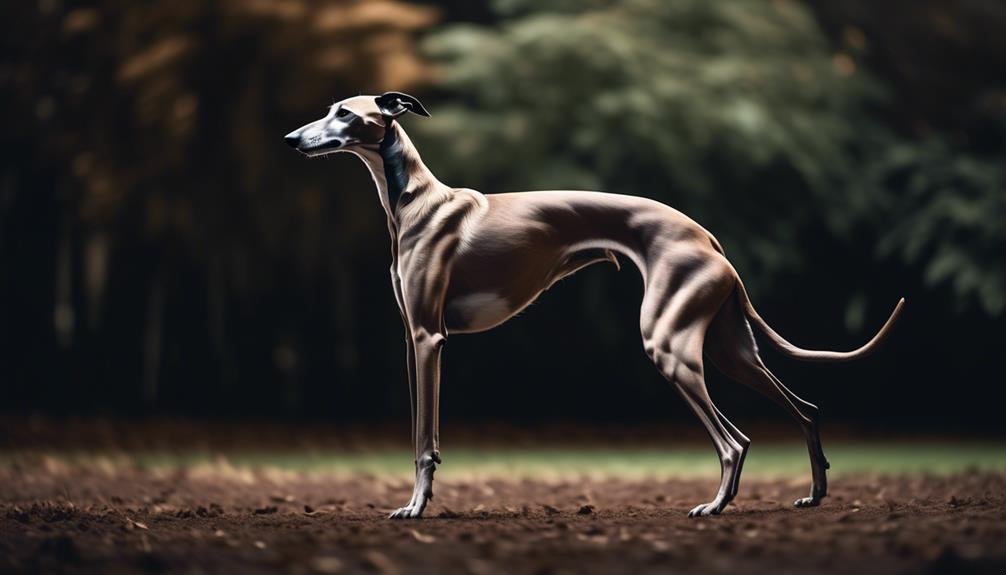
Greyhounds possess a distinct physical appearance that sets them apart from other dog breeds. They’re known for their sleek and slender build, deep chests, and long, slender legs. Their heads are long and narrow, with a tapered snout and small, rose-shaped ears that fold back at rest. Greyhounds have large, expressive eyes that are usually dark in color. They have a short, smooth coat in various colors, including black, fawn, blue, and brindle.
Despite their lean physique, Greyhounds are muscular and powerful, allowing them to reach incredible speeds of up to 45 mph. Their graceful and elegant appearance perfectly complements their impressive athleticism.
Temperament and Personality
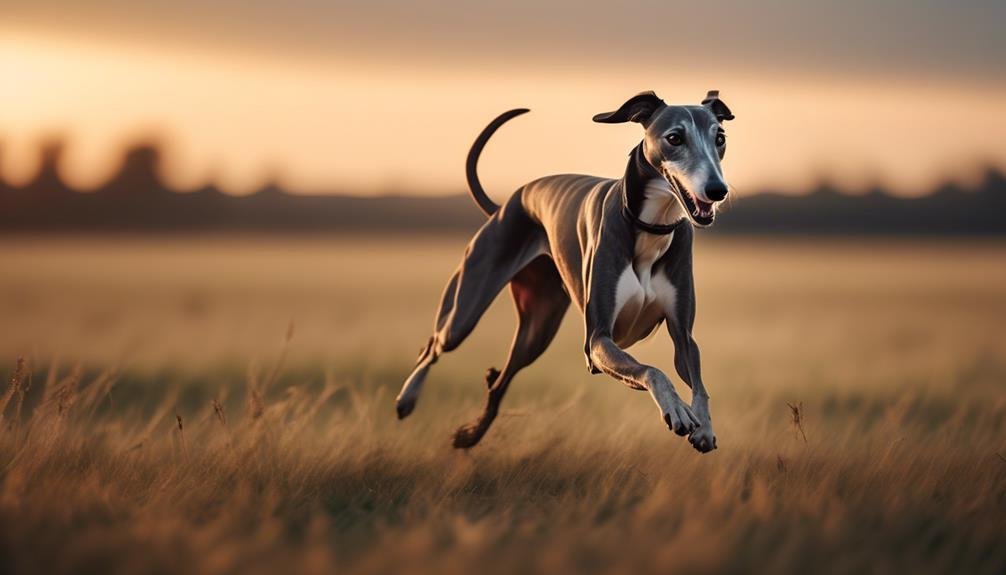
As we shift our focus to exploring the temperament and personality of Greyhounds, it’s essential to understand that their physical appearance isn’t the only remarkable aspect of this breed. Here are five key characteristics that define the temperament and personality of Greyhounds:
- Gentle and Affectionate: Greyhounds are known for their gentle and affectionate nature. They love being around their human companions and petting and cuddling.
- Calm and Quiet: Greyhounds are generally calm and quiet dogs. They aren’t prone to excessive barking and are well-suited for apartment living.
- Independent Thinkers: While Greyhounds are intelligent dogs, they can also be independent thinkers. They may not always follow commands unthinkingly, but they can be obedient and well-behaved with consistent training and positive reinforcement.
- Good with Children: Greyhounds are typically good with children and can be very patient and gentle. However, it’s important to supervise interactions between young children and dogs to ensure safety.
- Reserved with Strangers: Greyhounds can be reserved and aloof with strangers. They may take some time to warm up to new people, but they can be pretty friendly and welcoming once they do.
Understanding these temperament and personality traits will help you determine if a Greyhound fits your lifestyle and family.
Training and Exercise Needs
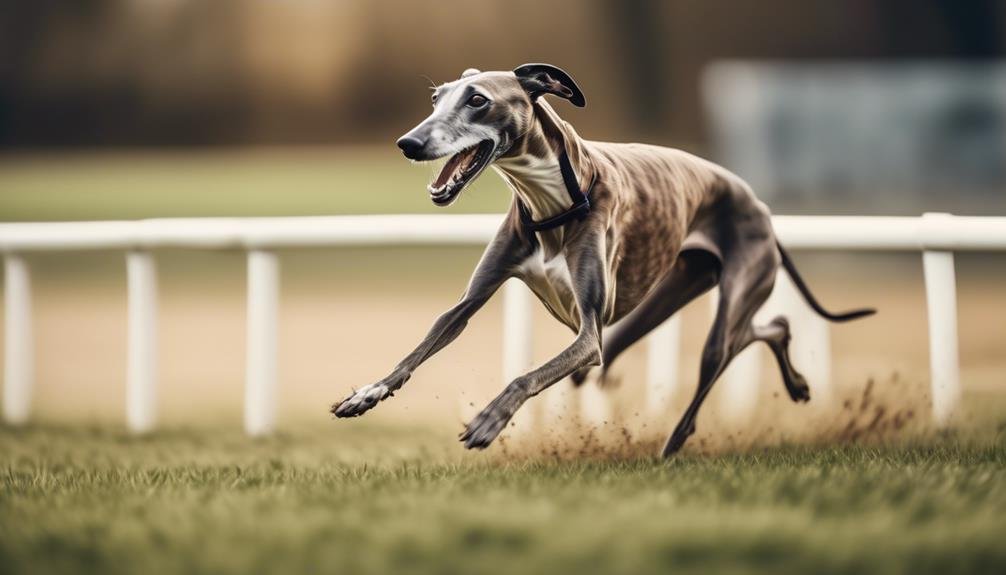
Regarding training and exercise, Greyhounds require a structured routine focusing on mental stimulation and physical activity. These dogs are intelligent and thrive with consistent training methods that use positive reinforcement.
It’s essential to provide them with mental challenges, such as puzzle toys and obedience training, to keep their minds engaged.
Greyhounds are known for their incredible speed and agility, so they benefit greatly from regular exercise. Daily walks or jogs are essential to keep them physically fit. Still, it’s important to remember that Greyhounds are sensitive and should be exercised in safe, enclosed areas to prevent them from running off.
It’s also essential to provide them with a comfortable and soft bed to relax after their exercise sessions.
Health and Common Issues
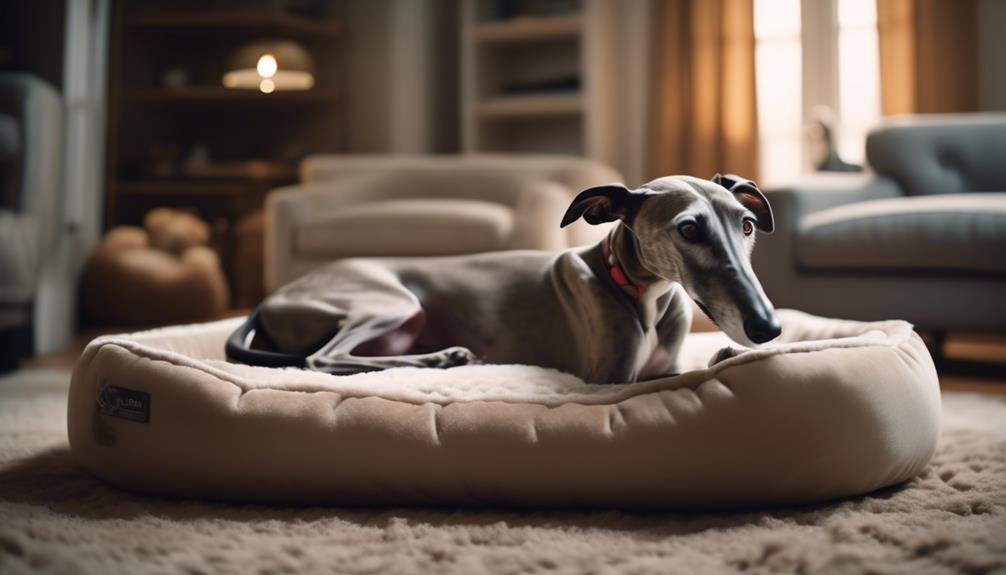
To ensure the health and well-being of your Greyhound, it’s essential to be aware of common health issues that can affect this breed. Here are five common health issues to watch out for:
- Bloat: Greyhounds are prone to gastric dilation volvulus (GDV), or bloat, a life-threatening condition that occurs when the stomach twists and traps gas inside. Immediate veterinary attention is crucial.
- Hip Dysplasia: This genetic condition causes the hip joints to develop improperly, leading to pain and arthritis. Regular exercise, a balanced diet, and weight management can help reduce the risk.
- Osteosarcoma: Greyhounds have a higher risk of developing bone cancer, particularly in the long bones of the legs. Early detection and treatment are crucial for the best possible outcome.
- Dental Issues: Greyhounds often have poor dental health due to their thin gums and crowded teeth. Regular dental care, including brushing and professional cleanings, is essential.
- Sensitivity to Anesthesia: Greyhounds can be more sensitive to anesthesia than other breeds, so it’s essential to inform your veterinarian about their breed when scheduling any procedures.
Grooming and Coat Care
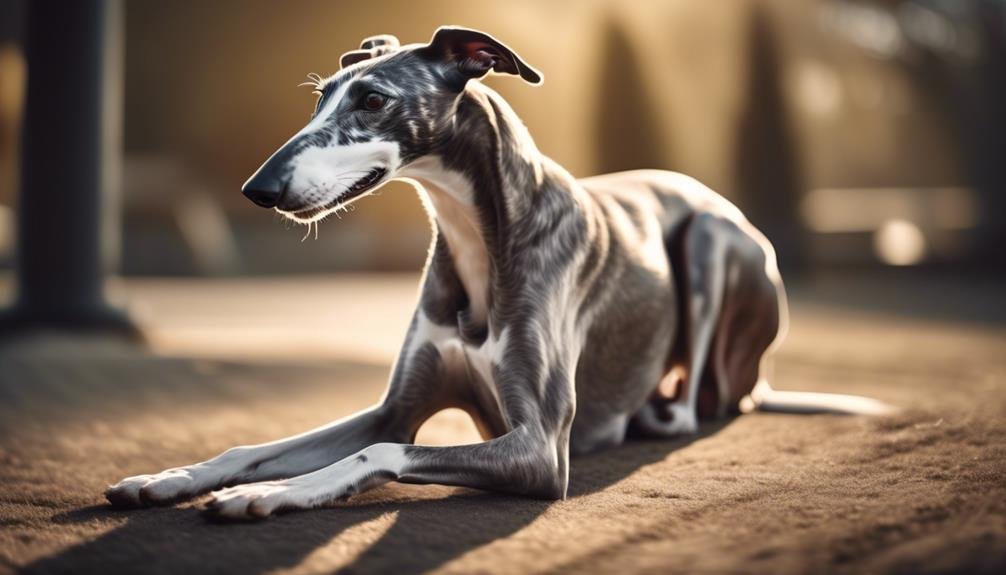
Grooming and coat care for Greyhounds are essential aspects of their overall health and appearance. Due to their short and sleek coat, Greyhounds are relatively low-maintenance in grooming. However, they require regular brushing to remove dead hair and keep their coat shiny. A rubber grooming mitt or a soft-bristle brush can gently brush your Greyhound’s coat. In addition to brushing, regular bathing is also necessary to keep their coat clean and free from dirt and odors. It is essential to use a mild shampoo specifically formulated for dogs to avoid drying out their skin. Lastly, don’t forget to check and clean your Greyhound’s ears regularly to prevent infections. These grooming routines will help keep your Greyhound looking and feeling their best.
| Grooming Tips for Greyhounds | Frequency |
|---|---|
| Brushing their coat | Weekly |
| Bathing | Every 6-8 weeks |
| Cleaning their ears | Weekly |
| Nail trimming | Every 2-3 weeks |
Feeding and Nutrition

Feeding and nutrition are crucial aspects of maintaining the health and well-being of your Greyhound. Here are five important considerations to keep in mind:
- Provide a balanced diet: Make sure your Greyhound’s meals consist of high-quality dog food appropriate for their age, size, and activity level. Look for options that contain real meat as the main ingredient, and avoid fillers or artificial additives.
- Monitor portion sizes: Greyhounds are prone to weight gain, so measuring their food and avoiding overfeeding is essential. Follow the recommended portion sizes provided by your veterinarian or the dog food manufacturer.
- Provide fresh water: Make sure your Greyhound always has access to clean water. Hydration is essential for their health and helps prevent urinary tract infections.
- Consider dietary restrictions: Some Greyhounds may have specific dietary restrictions or sensitivities. If your dog has any allergies or intolerances, work with your veterinarian to find a suitable diet that meets their nutritional needs.
- Regular feeding schedule: Establish a consistent feeding schedule for your Greyhound. This helps regulate their digestion and prevents overeating. Stick to the same time and place for meals to create a routine for your dog.
Living With a Greyhound
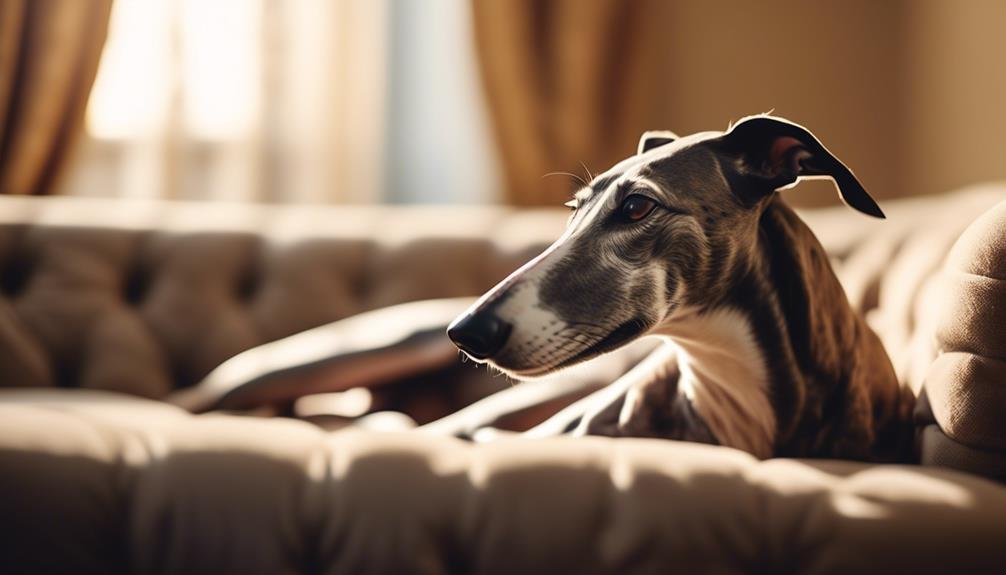
Living with a Greyhound can be a rewarding experience, as these regal and elegant dogs bring grace and beauty into your home. With their sleek and slender build, they are a sight to behold. Greyhounds are known for their gentle and affectionate nature, making them excellent companions. Here is a table showcasing some critical characteristics of living with a Greyhound:
| Living with a Greyhound | |
|---|---|
| Exercise Needs | Moderate to high |
| Grooming | Low |
| Temperament | Gentle, affectionate, and calm |
| Living Space | Greyhounds can adapt to both apartments and houses |
| Training | Greyhounds are intelligent and eager to please but can be independent |
Greyhounds require regular exercise to maintain their physical and mental well-being. Although they are known for speed, they are generally calm and well-mannered indoors. With their short coat, grooming needs are minimal. Training is essential to establish boundaries and ensure good behavior. Living with a Greyhound can bring joy and elegance to your life.
Greyhound as a Family Pet
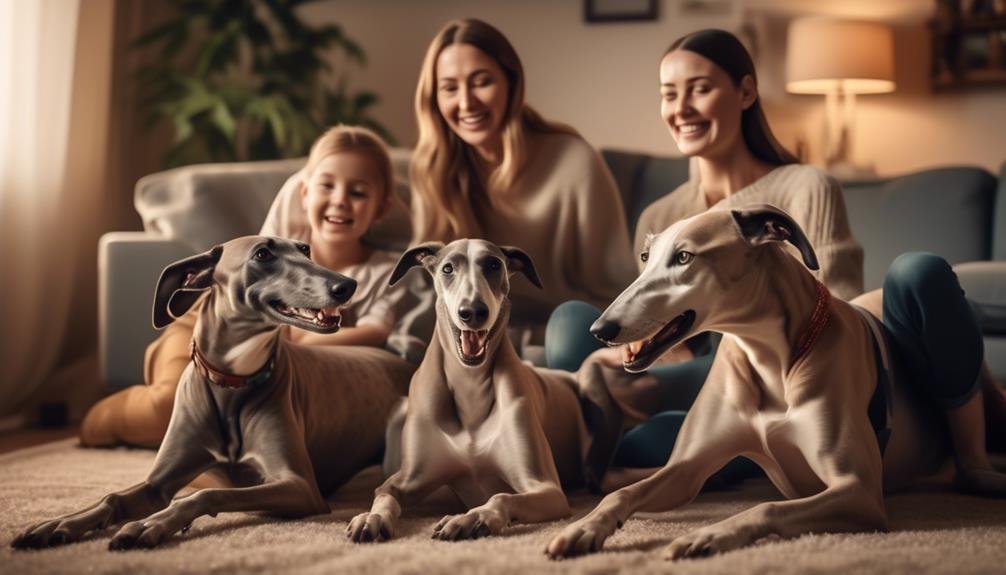
The Greyhound is an excellent choice for a family pet due to its gentle and affectionate nature, making it an excellent addition to any household.
Here are a few reasons why the Greyhound is a great family pet:
- Kid-friendly: Greyhounds are known for their gentle and patient temperament, making them well-suited for families with children.
- Low maintenance: Despite their athletic build, Greyhounds are low-energy dogs requiring minimal exercise. They’re content with a daily walk and playtime in a fenced-in yard.
- Good with other pets: Greyhounds have a generally peaceful nature and can get along well with other pets, including cats and small dogs.
- Easy to groom: Greyhounds are easy to groom with their short, sleek coats. Regular brushing and occasional baths are sufficient to keep their coat shiny and healthy.
- Laid-back demeanor: Greyhounds are known for their calm and relaxed nature, which makes them well-suited for households that prefer a more laid-back pet.
Adoption and Rescue Options
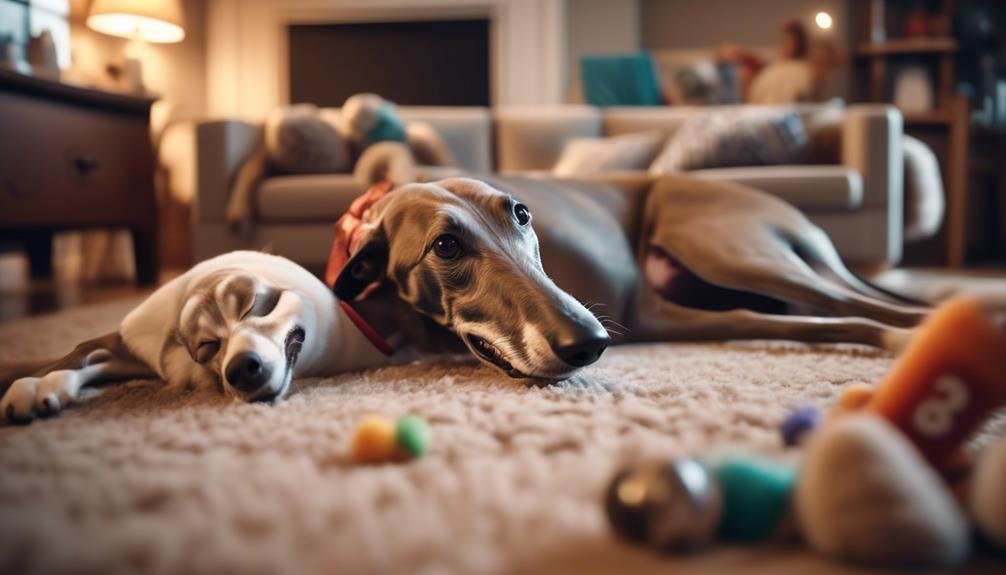
If you’re considering bringing a Greyhound into your family and are open to adoption or rescue options, several resources are available to help you find the perfect companion.
Greyhound adoption organizations, such as Greyhound Pets of America and the National Greyhound Adoption Program, are dedicated to finding loving homes for retired racing Greyhounds. These organizations provide comprehensive information about the adoption process, including application requirements, home visits, and post-adoption support.
Additionally, local animal shelters and rescue groups may have Greyhounds for adoption. These organizations often have a screening process to ensure the Greyhound is placed in a suitable home.
Adopting a Greyhound provides a loving home for a deserving dog and helps promote the welfare of these gentle and affectionate creatures.
Frequently Asked Questions
What Are Some Common Health Issues That Greyhounds Are Prone To?
Greyhounds are prone to specific health issues, such as bloat, osteosarcoma, dental problems, and hypothyroidism. Regular veterinary check-ups, a balanced diet, exercise, and proper dental care can help maintain their overall health and well-being.
Are Greyhounds Good With Children and Other Pets?
Yes, Greyhounds are generally good with children and other pets. They have a gentle and friendly nature. However, it’s important to supervise interactions and introduce them properly to ensure everyone’s safety and comfort.
How Much Exercise Does a Greyhound Need Daily?
A Greyhound needs at least one hour of daily exercise to stay happy and healthy. To meet their exercise needs, Engage in brisk walks, jogging, and playtime in a secure, fenced area.
What Is the Average Cost of Owning a Greyhound, Including Food, Vet Bills, and Other Expenses?
Owning a Greyhound can cost you around $1,000 to $2,000 annually, including expenses like food, vet bills, grooming, and other necessities. Budgeting for their well-being and providing the care they deserve is essential.
Are Greyhounds Prone to Separation Anxiety, and How Can It Be Managed?
Yes, Greyhounds are prone to separation anxiety. To manage it, gradually increase their alone time, provide mental stimulation with toys or puzzles, use calming aids like pheromone diffusers, and consider professional help if needed.
What are the similarities and differences between the Greyhound and Great Dane dog breeds?
The great dane breed information characteristics show that both the Greyhound and Great Dane are large and athletic breeds. Both have short coats and a gentle nature. However, Greyhounds are known for their speed and agility, while Great Danes are known for their size and protective instincts.
Conclusion
In conclusion, owning a Greyhound can be an enriching experience. Their incredible speed and elegant appearance make them a sight to behold.
Beyond their physical attributes, greyhounds are known for their gentle and affectionate nature, making them excellent companions for families and individuals.
A Greyhound can thrive in any loving home with proper training, exercise, and care.
So, why wait? Consider adding a Greyhound to your family and enjoy the joy and love they bring into your life.
